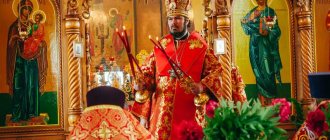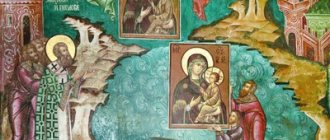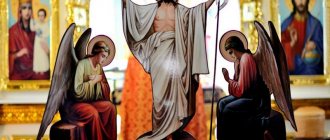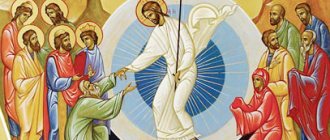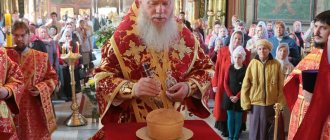The date of Orthodox Easter is determined according to the rule that was established at the First Ecumenical Council (325) in the city of Nicaea. According to this rule, Easter occurs on the first Sunday after the spring full moon and after the Jewish Passover, and falls on the period from March 22 (April 4, new style) to April 25 (May 8, new style).
Go to:
- Easter calendar for the 20th century
- Easter calendar for the 21st century
What date is Easter celebrated in 2022?
Easter marks the end of the 40-day period of Lent. The week leading up to Easter is called Holy Week by Christians because it commemorates the events surrounding the crucifixion, burial and resurrection of Jesus Christ.
Easter does not have a fixed date, but Orthodox Christians always celebrate it on the Sunday between April 4 and May 8
. Orthodox churches celebrate moving dates according to the Julian calendar, the Roman calendar first proposed by Julius Caesar in 46 BC. e.
In 2022, Orthodox Christians celebrate Easter on May 2 .
Traditions, rituals and fortune telling for Maslenitsa 2022
Signs and fortune telling for Maslenitsa about marriage
meet a drunk man on a holiday - the groom will soon appear;
the first pancake is smooth and ruddy - the girl will get married in the near future;
the pancake stuck to the frying pan and came out “lumpy” - no marriage in sight;
The number of holes in a pancake means the number of children there will be.
If a girl takes the first baked pancake out into the street, gives it to a passing man and asks his name, her future husband will be called the same.
One of the fortune tellings for unmarried girls looked like this: young ladies baked pancakes, went out into the street and treated them to the first person they met, asking his name. Whatever his name was, the betrothed will have the same name.
Girls who wanted to get married quickly tried to get their guests drunk, because according to legend, meeting a tipsy person on
Maslenitsa is also a good omen, promising a happy and long marriage.
The young men, in turn, walked around the village and collected bast shoes from the courtyards. After that, at the intersection they waited for people returning from the market, stopped them and asked the question: “Are you bringing Maslenitsa?”
If they answered, “No luck,” then the young men would hit the passers-by with their bast shoes.
The bear was considered the constant companion of Maslenitsa in Rus'. After all, the clubfoot sleeps in its den all winter, and if it wakes up, it’s a sure sign that spring has come. Therefore, during the festivities, men pulled on a bear skin and started dancing along with their fellow villagers. And in large cities, live bears were also brought to Maslenitsa.
Why is Easter celebrated in the spring?
According to the Bible, the death and resurrection of Jesus Christ occurred during the Jewish Passover (Passover).
In 325, the church held the First Ecumenical Council, known as the Council of Nicaea. Until this time, churches around the world celebrated Easter at different times.
To achieve unity between the churches, the members of the cathedral created a formula for a single day of celebration of Easter.
It was decided to celebrate Easter on the first Sunday that falls after the first full moon after the vernal equinox, but always after the Jewish holiday of Passover.
To avoid further confusion, the date of the vernal equinox was determined to be March 21st. This system ensured that all churches would celebrate Easter together on the same day.
Although the Council of Nicaea established the date of Easter for churches around the world, not all Christian churches observe Easter according to the Gregorian calendar. Orthodox churches celebrate Easter according to the Julian calendar.
Traditions of Maslenitsa celebration
Maslenitsa is a hot mixture of paganism and Christianity. In ancient times, the Slavs rode horses for a whole week, ate pancakes and treated their neighbors to them, and also held noisy celebrations. The day of the week was also of great importance:
Monday - “Maslenitsa meeting” - people rolled out ice slides, made a straw effigy, set tables with sweets;
Tuesday - “flirt” - the guys were looking for brides, and the girls were looking for grooms, the young people rode down the slides together and ate pancakes;
Wednesday - “gourmet” - the whole day was devoted to festive delicacies and treats;
Thursday - “take a walk” - the Slavs organized horseback riding, drove away winter and called for spring, and the men built snow castles, then divided into those who would attack the fortress and defend it;
Friday - “mother-in-law's evening” - the day when the son-in-law should come to visit his mother-in-law with pancakes;
Saturday - “sister-in-law's get-togethers” - people gather with the whole family at the table or go to visit relatives with pancakes;
Sunday is “forgiveness day” - the date when family and friends ask each other for forgiveness for their actions.
But the most long-awaited moment was the burning of the Maslenitsa effigy. It symbolized saying goodbye to the cold and welcoming spring. Fortune telling on Maslenitsa is an invariable attribute of the holiday.
By the way, the last day of Maslenitsa was celebrated especially magnificently: young people set fire to the effigy, danced around it, sang and danced. The ritual was aimed at driving away winter and welcoming spring. The holiday ended with jumping over a separate fire.
Orthodox and Catholic Easter
The date on which Christians celebrate Easter not only differs every year, but also between the Orthodox and Catholic churches. This is due to the fact that they use different calendars to calculate the date of Easter: the Catholic one uses the Gregorian calendar, and the Orthodox calendar uses the older Julian calendar.
Currently, the old Julian solar calendar is 13 days behind the Gregorian calendar, and its lunar calendar is 4-5 days behind, which is why the date of Orthodox Easter often does not coincide with the date of Catholic Easter. Therefore, Easter for Catholics most often occurs in the period from March 22 to April 25
according to the Gregorian calendar.
Orthodox Easter is usually celebrated 1-5 weeks later than Catholic Easter, but sometimes their dates coincide, as in 2017. The next coincidence will occur in 2025.
How to determine the date of Easter
In addition to the above method, there is also an arithmetic one. It consists of simple operations and numbers and was invented by Gauss, a German mathematician and scientist in the 19th century.
Easter is celebrated on the first Sunday after the spring full moon
First you need to divide the number of the desired year by 19 and select the remainder. The same thing needs to be done two more times, but with the numbers 4 and seven. We have 3 remainders after each action. Now we multiply the first remainder by 19 and divide by 30, find the remainder. We multiply the second remainder by 2, the third by 4, the fourth by 6. We add the resulting data and add 6, divide by 7. We find the remainder again.
If the sum of the fourth and fifth balances is less than 9, then the month of celebration is March. Now all that remains is to determine the date. Let's add the fourth and fifth remainders and add 22. The resulting number is the date of the celebration.
If the sum of the fourth and fifth remainders is greater than 9, then the month of celebration is April. To determine the date, add the fourth and fifth remainders and subtract 9. The resulting number is the date of the celebration. This method will be relevant until 2101. Later, due to a break in calendars, it will be slightly changed.
What not to do on Easter Sunday
On the bright holiday of Easter, as on any other holiday, give your recommendations:
1. Easter is a day of joy, so it is better to refrain from any unpleasant memories. Believers remember the risen Christ, and not the deceased.
2. On this day there is no need to start important business negotiations or sort things out.
3. Don't drink and indulge in gluttony. Everything should be in moderation, both food and drink! The main food on this day is spiritual.
4. It is not advisable to do repairs, cleaning, washing windows, or visiting a beauty salon. All this must be done in advance so that nothing distracts you from a pleasant celebration. But there are no strict prohibitions.
So everyone has the right to act according to their conscience. In addition, someone may be at work on this day. And he is obliged to fulfill his professional duty.
5. On this day you should not visit cemeteries. There are other days to honor deceased relatives. After all, Easter is a celebration of the triumph of life over death.
On this spring day of the Bright Feast of Christ's Resurrection, anyone can feel like a small part of something great and beautiful.
On this day you come into contact with a holy action, and perhaps with the main phenomenon in history for all mankind. And celebrating Easter is a great honor for every believer.
Easter service
Holy Week ends with one of the largest church holidays - Easter. For all Christians, this day begins with a church service , lasting from midnight until dawn.
At the end of the service, the priests distribute the Holy Fire . Many people take it into the house and try not to extinguish it on the way. The lamp is placed at the head of the table and they try to keep the fire going until the next Easter holiday.
Easter Vespers at the Archangel Michael Cathedral in Izhevsk
The main rite is the blessing of Easter baskets with eggs, Easter cakes and meat, when at the end of the service people gather around the church.
Signs for Maslenitsa 2022
There is a sign that the more pancakes you bake for Maslenitsa, the more happiness awaits you. If you skimp on treats, then there will be trouble both with your finances and with your health.
During the process of preparing pancakes, it was necessary to be in a good mood, keep only good thoughts in your head and wish everyone who treated themselves to a pancake goodness and happiness. By the way, there are also special “pancake” signs.
For example, the number of pancakes a housewife bakes, the number of sunny, joyful days she will have a year.
And if the first pancake turns out golden and ruddy, then harmony, peace and happiness will reign in the family all year long.
It is also believed that you should not cut pancakes with a knife, otherwise you can bring illness to your loved ones.
Jewish Passover
The tradition of celebrating Easter dates back to Old Testament times. Only then it had a different meaning and significance, and the name sounded somewhat different. Jewish Passover is translated as “pass, pass by” and is associated with the events of the deliverance of the Israeli people from enslavement by Egypt.
The custom of annually remembering and honoring the Exodus of the Jewish people from slavery was established by God Himself through the prophet Moses. From Scripture we know that the Lord Jesus Christ, who came not to break the law, but to fulfill it, also took part in this holiday - after the Jewish Passover He was crucified.
The date of Passover celebration fell on the period from the 14th to the 21st of the month of Nisan, which approximately corresponds to our March. This month was the first in the Jewish calendar; the moment of ripening of the ears served as a reference point for determining its beginning. After the destruction of Jerusalem, this landmark was lost, so the Jews had to switch to the lunar calendar.
Easter traditions from different countries
- In Bulgaria, clay pots are made at Easter, the surface of which is later covered with notes with good wishes. The pots are then thrown from tall buildings to celebrate the victory of good over evil. Passers-by often pick up fragments and take them with them for luck.
- Poland celebrates Easter for two whole days in a row. On Sunday, Poles gather around the table for a solemn meal, which begins with prayer. A traditional Polish holiday dish is mazurka - a shortcrust pastry pie with nuts and fruits. And the second day in Poland is called Wet Monday, on which Poles, with a clear conscience, pour water on each other. For some reason it is believed that this brings happiness.
- In England , Easter is so highly valued that schoolchildren have a two-week Easter holiday. At this time, the British treat each other with chocolate eggs.
- Everyone has heard about the Easter bunny - a symbol of Easter in Germany . According to fairy tales, it is he who gives children colorful eggs. Fun fact: the Germans make an Easter tree and decorate it with eggs.
- In Italy , the Resurrection of Christ is a real holiday of the belly. In addition to decorating eggs, Italians bake cheese cakes - colomba and Neapolitan pie, and cook lamb. The Pope himself conducts the Mass in the main square of the Vatican!
- France is another lover of chocolate holiday paraphernalia. The French, like the British, treat each other with chocolate eggs. But the main tradition is still considered to hide chocolate bunnies and chickens from children in the garden, which the children must put in baskets. As a traditional dish, the French prefer fried chicken strewn with spices and baked potatoes.
- Australians prefer to spend their holidays outdoors with their family. Easter delicacies include roast lamb or chicken, and fruit cake.
- The traditions of the USA are very similar to the traditions of France. Adults organize a chocolate egg hunt for children.
Lighting Easter cakes and eggs
On Easter, all believers rush to church on the night from Saturday to Sunday for the all-night service. And if they couldn’t get to the temple, they come during the day to bless the Easter cakes and eggs. The symbols of the holiday are carefully placed in decorated wicker baskets.
This tradition of consecration prepares the believer for the bright waves of the holiday. There is a special atmosphere in the church that is difficult to feel at home or on TV, even watching a live broadcast.
Therefore, it is on this bright day that you must definitely go to the temple. It is also recommended to treat those in need with Easter cakes and eggs.
Maslenitsa week by day - what are they called and what should you do?
Each day of Maslenitsa week has its own name and carries a special meaning. The first three days of the week are called Narrow Maslenitsa. Wide Maslenitsa lasts from Thursday to Sunday, on these days people take to the streets, dance in circles, dance and sing.
Monday – meeting The parents of the newlyweds met, discussed the time and place of the festivities, and the composition of the guests. By this day, the construction of snow mountains and swings was completed, and pancakes began to be baked. A scarecrow was made from straw and rags and placed on a stake.
Tuesday - flirting On this day, brides' viewings took place. All Maslenitsa rituals boiled down to matchmaking in order to have a wedding after Lent.
Young people rode down the snowy mountains and ate pancakes in the company of family and friends.
Wednesday - a gourmet The son-in-law came to his mother-in-law for pancakes, which she had to bake with her own hands. In this way, the wife's mother demonstrated her affection for her son-in-law. Other guests also took part in the treats. Thursday - revelry From this day the wide Maslenitsa began, household work stopped, celebrations unfolded in full swing. The people indulged in all sorts of fun, horse riding, fist fights, and various competitions were held, which ended with noisy feasts.
The main action on Thursday is the assault and further capture of the snowy town. Maslenitsa festivities were everywhere accompanied by the lighting of fires and ritual jumping over fire.
Friday - mother-in-law's evening The mother-in-law came on a return visit to visit her son-in-law. The daughter, son-in-law’s wife, baked pancakes that day. The mother-in-law came to visit not alone, but with her relatives and friends. On this day, the son-in-law showed his affection for his wife's mother and her relatives.
Saturday - sisters-in-law's gatherings Young wives invited their sisters-in-law (husband's sisters), as well as his other relatives, to visit them. If the sister-in-law was unmarried, then the hostess also invited her unmarried friends; if the husband’s sisters were married, then the hostess’s married relatives were invited.
Sunday - farewell The culmination of the entire Maslenitsa week, also called Forgiveness Sunday. On this day, a conspiracy took place before the beginning of Lent. All close people asked each other for forgiveness for all the troubles and insults caused over the year.
At the end of the holiday, the effigy of Maslenitsa was solemnly burned. The tradition is still maintained, implying farewell to winter.
Calculating the time of Easter celebration
Calculation of the day of the Jewish Passover
Based on the prescriptions set forth in the book of Exodus, as well as the lunisolar calendar, finally adopted by the Jews in the era of the second temple, the Jewish Passover is celebrated on the 15th of the month of Nisan. Thus, among the Jews, the holiday of Passover is immovable.
In the modern Jewish calendar, the months are no longer established, as was the case in ancient times, by direct observation of the lunar phases, but are determined by the cycle. Since the beginning of each month coincides with some essentially fictitious new moon (moled), the fifteenth day coincides with the full moon. The month of Nisan is closest to our March, so the ruling on the Jewish Passover can be formulated in such a way that it is celebrated on the first spring full moon, calculated according to well-known regulations.
The so-called starting point of the Jewish chronology is taken as moled of creation or moled of the month of Tishri of the first year, which took place, according to Jewish calculations, in 3761 BC, on October 7 at 5 o'clock 204 hlakim (khlak - 1/1080th of an hour) after six o'clock in the evening under the meridian of Jerusalem, or, in our opinion division of the day, October 6 at 11:11 pm.
According to some rabbis, this moled came in the year before creation, when, as the book of Genesis puts it (1:2), thohu webohu prevailed. Therefore, Jewish chronologists call this moled moled thohu. The time interval between two new moons is taken to be 29 days 12 hours 793 hlakim, which represents Hipparchus’ definition of the synodic month of the moon.
Since all changes occur in the first half of the year, from Tishri to Nisan, the number of days passing from Easter to the New Year is always 163 and therefore it makes no difference whether to calculate the day of Passover or 1 Tishri of the next year. Detailed calculation rules are set out in the book of Moses Maimonides “Kiddusch hachodesch” (“Kiddush ha-chodesh”).
The following rules, remarkable in their simplicity, for calculating the day of the Jewish Passover in the year of the Julian calendar were given by the famous mathematician Gauss without proof in the Monatliche Correspondeoz for 1802. These rules were proven by Cysa de Cresy in the Notes of the Turin Academy of Sciences (1818).
Let B be the number of the Christian year, i.e. B = L – 3760, where A is the number of the year of the Jewish calendar. Let's call the remainder of division of 12B +12 by 19 by a; the remainder of B divided by 4 through b. Let’s compose the value: M + m – 20.0955877 + 1.5542418a + 0.25b – 0.003177794B, where M is an integer and m is a proper fraction. Finally, we find the remainder c from dividing the value M + 3B + 5b +1 by 7.
Then: 1) if c = 2 or 4, or 6, then the Jewish Passover is celebrated on M + March 1 (or, what is the same, M – April 30) old style; 2) if c = 1, moreover a > 6 and, in addition, m > 0.63287037, then Easter will take place M + March 2; 3) if immediately c = 0, a > 11 and m > 0.89772376, then Easter day will be M + March 1; 4) in all other cases, Easter is celebrated on March 1st.
As a result of the above, the 1st Tishri of the next year will occur on P + August 10 or P – September 21, where P is the day of Passover in March. Generally speaking, it is enough to calculate to the second decimal place. A more accurate calculation is only necessary in extremely rare doubtful cases.
Example: if B = 1897, then a = 14, b = 1, M + m = 36.04, i.e. M = 36, m = 0.04, s = 0. Easter Day: March 36, or April 5, old style. The New Year began on September 15th.
Calculation of the day of Christian Easter
It must be assumed that already in the 3rd century, thanks to the works of the Alexandrian Church, which was considered the most learned, rules were developed that were confirmed by the Councils of Nicaea and Antioch and remained in full force to this day.
Namely: to celebrate Easter after the Jewish Passover, on the first Sunday after the full moon, which, being calculated according to well-known prescriptions, will occur on the day of the vernal equinox or immediately after it. March 21st was taken to be the day of the vernal equinox. To calculate the phases of the moon, so-called moon phases were used. cycles of the moon, i.e. periods after which the phases of the moon returned to approximately the same days of the Julian year.
Several such cycles were used. The bishop's Easter rules have been preserved. Hippolytus, which were completed on a sixteen-year cycle. The Roman Church almost to the century. used the 84-year cycle.
The Alexandrian Church (Bishop Eusebius?) introduced the most accurate 19-year cycle, discovered by the Athenian Meton and used in the Greek calendar. Since the Alexandrian Church was entrusted by the councils with monitoring the correctness of the celebration of Easter, at the end of the century. entered into a heated argument with Rome, pointing out irregularities due to the 84-year cycle adopted there.
Since then, the 19-year Metonic cycle has gradually come into use in Western churches, but it was finally established only thanks to the works of Dionysius the Less.
Due to the accepted rules, it is necessary to know for each year the Sundays in March and the day of the Easter full moon. Sunday days are determined from the fact that in the year preceding the Christian era (leap year), which is sometimes incorrectly called the zero year of our chronology, Sundays fell on March 7, 14, 21, 28; further, in every simple year, consisting of 52 weeks and 1 day, Sundays recede in numbers by one, in a leap year, consisting of 52 weeks and 2 days, by two units.
The Metonian lunar cycle comprises 19 Julian years in 365.25 days and almost 235 synodic months of the moon in 29.53059 days. The difference between these two periods is 0.0613 days. The lunar months in this cycle consist alternately of 30 and 29 days, and when the Julian year contains 13 new moons, an additional month of 30 days is inserted at the end of it, and at the end of the last, nineteenth year of the cycle - a month of 29 days. With this distribution, February is always counted as 28 days (permanent calendar), so that the lunar month that falls on February 25, the intercalary day of a leap year, is actually extended by one day.
Since January and February are 59 days long, it follows that the same cyclic phases of the moon will fall on the same dates in January and March. The ancients did not actually observe the new moon, but the first appearance of the new moon; the time interval between this appearance and the full moon is approximately 13 days, and therefore in Paschal the full moon is determined from the new moon by adding 13 days.
The Easter full moon is called the Easter limit. During the first year of the cycle, the Alexandrian Church adopted the so-called. the era of Diocletian (285 AD), when the Easter new moon fell on March 23, and the first new moon of the year on January 23; On the same day, according to the Metonic cycle, there is a new moon in the year preceding the Christian era. This year was accepted as the original by Dionysius the Small.
The number showing the place of a year in the cycle is called the golden number. The origin of this name is controversial. The Jews, who also used the Metonic cycle, accepted its beginning three years later than the Alexandrian Church and Dionysius, and in this shifted cycle the new moon in the initial year falls on January 1.
This cycle, called the Easter circle of the moon, is used in the Paschal of the Orthodox Church. To distinguish it, Dionysius calls one of these cycles (Jewish) riclus lunaris, the other - ciclus decemnovennalis. The indicated excess of 19 Julian years over 235 synodic months causes the new moons calculated using the Metonic cycle to lag behind the actual astronomical ones. Every 310 years, one day is accumulated. By the end of the 19th century. this difference was more than five days, for example. The Easter new moon of 1897, calculated according to the cycle, was on March 27, while the astronomical one was on March 21 in the evening.
Of all the practical formulas proposed for calculating the day of Easter based on the above rules, by far the simplest and most convenient belong to Gauss.
They are as follows. Let us call through a the remainder of dividing the number of the year by 19, through b the remainder from dividing it by 4, and through c from division by 7. Next, we will call the remainder from dividing the value 19a + 15 by 30 d and the remainder from dividing it by 2b + 4c + 6d + 6 by 7 let it be e. Easter Day will be March 22 + d + e or, which is the same, d + e – April 9. These seven lines contain the complete Paschal of the Julian calendar, adopted by the Orthodox Church.
Example: for 1897 a = 16, b = 1, c = 0, d = 19, e = 3, Easter day April 13. From the expression March 22 + d + e it can be seen that the earliest Easter (with d = e = 0) can occur on March 22; this is clear from the meaning of the rules. On the other hand, the largest value for e is six, and from the solution of the indeterminate equation it follows that, due to the condition that a is less than 19, d cannot be equal to 29, but only reach 28. Therefore, the latest Easter occurs on April 25.
The rules for celebrating Easter are sometimes paraphrased as follows: Easter should be celebrated on the first Sunday after the full moon, which will occur no earlier than March 19, and the day of the full moon is determined by the Easter circle of the moon according to church regulations; if the March full moon found in this way occurs earlier than March 19, then Easter should be celebrated on the first Sunday after the next full moon, which will be 30 days later, in April; in both cases, if the full moon falls on Friday, Saturday or Sunday, Easter should be celebrated a week later - on the following Sunday. In this form the rules were formulated by prof. Savich. They coincide with the above.
With the introduction of the Gregorian calendar in 1582, the basic rules for calculating the day of Easter remained the same. But due to changes made in the calendar, the day of Easter, generally speaking, does not coincide with that calculated according to the Julian calendar.
It should be noted that the Gregorian calendar does not follow the rule that Christian Easter is celebrated after the Jewish one: sometimes it coincides with the Jewish one, sometimes it falls on the lunation earlier. In 1582, ten days were discarded and, in addition, it was decreed that years with which centuries end should not be considered leap years, unless the number of elapsed centuries is divisible by four; however, in both cases, the order of the days of the week remains unchanged. It follows that Sundays will coincide with other months than in the Julian calendar.
By the time the Gregorian calendar was introduced, the phases of the moon, calculated according to the cycle, were already three days behind the actual ones, so the papal commission led by Aloysius Lilius decided to move the lunar cycle by three days and, in addition, to avoid the accumulation of errors for the future instead of golden numbers enter the epact circle.
Epakta (ὲπάγειν - add) is the growth of the moon on January 1, i.e. the time elapsed since the last new moon of the previous year as a result of the excess of the solar year over the lunar year, consisting of 354 days. In the Julian calendar, the Roman epact is the waxing of the moon on January 1, calculated under the assumption that in the initial year of the lunar cycle, or at the golden number zero, the new moon falls on January 1, as occurs in the Jewish lunar cycle.
During the reform of the calendar, due to the rearrangement of the lunar cycle and the skipping of ten days, the new moon of the first year in the lunar cycle moved from January 23 to 30, and the previous one fell to December 31; therefore, the epact of the first year in cycle 1. The epacts of subsequent years are obtained by adding 11 each time and lowering numbers that are multiples of 30. To return to epact 1, when moving to a new cycle, you need to add 12; this was called saltus epactae or saltus lunae.
In order to avoid new errors, Lilius introduced epact amendments. One of them is called the solar equation and comes from throwing out three leap days for 400 years and therefore each time reduces the epact (reduces the number of days that have passed since the new moon). The second is called the lunar equation and aims to correct the discrepancy between 19 Julian years and 235 synodic months of the moon; it is added 8 times every 2500 years and each time increases the epact, since according to the Metonic cycle the phases of the moon are delayed. Both of these amendments are applied to epacts in the years that end centuries.
Thus, in 1700, when the solar equation had to be corrected for the first time, the Gregorian epacts decreased by one; in 1800 both amendments were applied and the epacts remained unchanged; in 1900, the epacts will again decrease by one and then remain unchanged until 2200, since neither correction will be applied in 2000, and both in 2100.
From the above it follows that practical formulas for calculating the day of Easter in the Gregorian calendar should be much more complicated than in the Julian calendar.
Nevertheless, Gauss presented them in the following elegant form. Let the remainders from dividing the number of the year by 19, 4 and 7 be a, b and c, respectively; the remainder of dividing the value 19a + M by 30 will be d and the remainder of dividing the value 2b + 4c + 6d + N by 7 will be e. Then Easter will come on March 22 + d + e or d + e - April 9 of the new style. The values of M and N are calculated as follows. Let k be the number of centuries in a given year, p the quotient of 13 + 8k divided by 25 and q the quotient of k divided by 4. Then M will be defined as the remainder of 15 + k – p – q divided by 30 and N as the remainder of dividing 4 + k – q by 7. Here, however, two exceptions must be borne in mind, namely: when, with d = 29, the calculation gives for Easter day April 26, one must take April 19 instead, and when, with d = 28, we get April 25 for Easter, and a > 10, then we need to take April 18. Calling by h the quotient of dividing a by 11 and by f the quotient of dividing d + h by 29, in addition, denoting d – f by d and considering e as the remainder of dividing 2b + 4c + 6d + N by 7, we obtain the formula for the day Easter: March 22 + d + e, which no longer requires any exceptions. Example: for 1897 a = 16, b = 1, c = 0, k =18, p = 6, q = 4, M = 23, N = 4, d = 27, e = 0. Easter Day April 18 (new style). Each of the values of M and N is constant, at least for a whole century, and therefore it is more convenient to calculate them in advance.
Their values will be:
- 1800-1899 M=23 N=4
- 1900-1999 M=24 N=5
- 2000-2099 M=24 N=5
- 2100-2199 M=24 N=6
- 2200-2299 M=25 N=0
- 2300-2399 M=26 N=1
- 2400-2499 M=25 N=1
The formulas given by Gauss for the Julian calendar can be obtained as a special case from the formulas for the Gregorian calendar, constantly assuming M = 15, N = 6. Using Gauss’s formulas, it is possible to solve the inverse Paschal problem for the Julian calendar: find those years in which Easter falls on given number. A general solution to a similar question for the Gregorian calendar, given the current state of numerical analysis, is impossible.
In the Paschal of the Orthodox Church, some terms have been preserved that require clarification. In church calendars, or monthly calendars, one of seven Slavic letters is assigned to each day of the year; Z, S, E, D, G, V, A, called adult letters. The year in church Easter begins on March 1; to this day, on the basis of some considerations concerning the biblical days of creation, the letter G is assigned; the following days have the letters B, A, Z, O, E, D, G, V, A, Z, etc. The letter to which Sundays correspond in a given year is called vrutselet.
Thus, knowing vrutseleto and having all the days of the year written in vrutseleto letters, you can easily find out the day of the week for any day of the year. T.N. The Easter circle of the moon coincides with the Jewish circle, i.e. deviates by three years from that adopted by Dionysius. The new moon in the initial year of this cycle falls on January 1st. The base is the number showing the age of the moon by March 1, found under the assumption of the Easter circle of the moon. The Great Andiction is a period of 532 years; since the phases of the moon return to the same numbers of months after 19 years, and the days of the week (taking into account leap years) after 28 years, then after 28 x 195 = 32 years all these elements will return to their previous order, and the days of Easter according to the Julian calendar will repeat absolutely right. The boundary key is the number of days between March 21 and Easter. Since the latest Easter is April 25, the boundary key can reach a value of 35.
In the so-called of the sighted Easter, the key of boundaries is indicated instead of numbers by letters of the Slavic alphabet. For each year of the great indiction, a key letter is given, and from it, from another table, the day of Easter is found, as well as the days of other moving holidays associated with it. From Gauss's formulas it follows that the key of the boundaries K = d + e + 1. Then we have: the beginning of Shrovetide (meat empty) in a simple year K + January 24, in a leap year K + January 25; the beginning of Lent (Clean Monday) in a simple year K + February 1, in a leap year K + February 2; Ascension K + April 29; Trinity Day K + 9 May; the plot of Petrov's fast K + May 16; The duration of Petrov's fast is 43 – K days.
For detailed information about the church Paschal, see Ilyashev, “Guide for teaching Paschal.” The table of sighted Paschal is placed at the end of the church book, called the Followed Psalter.
Easter calendar for 2020-2030
In order not to waste time on calculations, you can look at the Easter calendar for 2020-2030.
| Year | Catholic | Orthodox |
| 2020 | 12.04 | 19.04 |
| 2021 | 4.04 | 2.05 |
| 2022 | 17.04 | 24.04 |
| 2023 | 9.04 | 16.04 |
| 2024 | 31.03 | 5.05 |
| 2025 | 20.04 | 20.04 |
| 2026 | 5.04 | 12.04 |
| 2027 | 28.03 | 5.05 |
| 2028 | 16.04 | 16.04 |
| 2029 | 1.04 | 8.04 |
| 2030 | 21.04 | 28.04 |
Regardless of which denomination the parishioner belongs to - Catholic or Orthodox, the spiritual meaning of the holiday remains unchanged. For believers, the resurrection of the Son of God marks victory over death and hope for eternal life.
Easter symbols
- Easter cake is an integral attribute of Easter . The custom of baking and blessing Easter cakes has been observed by our ancestors since truly ancient times. Each housewife bakes Easter cakes in her own way, using family tricks that are passed down through generations and centuries. A cake is considered successful if it turns out airy, soft and tall.
Today there are more Easter cake recipes than Easter cakes themselves. However, one ingredient remains constant - you need to bake with a calm soul and bright thoughts.
- The Holy Fire is a self-igniting flame on the Holy Sepulcher, symbolizing the miracle of the resurrection of Christ.
- Easter eggs (colored eggs) are a symbol of the miracle of birth, new life and fertility. Even the ancient Egyptians, Greeks and Romans gave each other eggs as a symbol of the end of winter and the beginning of life.
Initially, eggs were painted red only with onion skins. Since that moment, many innovations have appeared: painting in different colors, painting, and now thermal stickers with images of temples and faces of saints.
The latter method of decoration is not encouraged because after peeling, the images of saints end up in the trash.
- Easter flowers , in particular, lilies of the valley, tulips, daffodils, hyacinths, are an attribute of the holiday and a symbol of the arrival of spring and the awakening of nature.
What to cook for the festive table for Easter
With the onset of Easter, the strictest period of Lent ends. And after such a test, the joy of the holiday only increases. What dishes can you prepare for the holiday table?
In addition to Easter cakes and colored eggs, any other baked goods (kulebyaki, pies, sweet buns) and various meat dishes (baked veal, boiled pork, any poultry) should be present. Cottage cheese Easter is also prepared from selected fatty cottage cheese and butter.
As for drinks, it is better to give preference to red wine; it is advisable to purchase church “Cahors” in advance. Any homemade red wine is also welcome.

